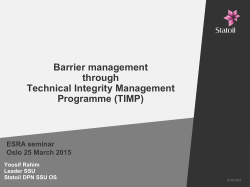
Electronic Supplementary Material (ESI) for ChemComm.
Electronic Supplementary Material (ESI) for ChemComm. This journal is © The Royal Society of Chemistry 2014 MoS2 nanosheet/TiO2 nanowire hybrid nanostructures for enhanced visible-light photocatalytic activities Meng Shen,a Zhiping Yan,a Lei Yang,a Pingwu Du,*a Jingyu Zhang,b Bin Xiang*a aDepartment of Materials Science & Engineering, CAS key Laboratory of Materials for Energy Conversion, University of Science and Technology of China, Hefei, Anhui, 230026, China. bMolecular Foundry, Lawrence Berkeley National Laboratory, 1 Cyclotron Rd, Berkeley, CA 94720, USA. * To whom correspondence should be addressed. binxiang@ustc.edu.cn; dupingwu@ustc.edu.cn Experimental details Synthesis of TiO2 wires: The TiO2 nanowires were synthesized by electrospinning with the following steps (schematic illustration of the setup seen in Figure S1). Tetra-n-butyl titanate was dissolved in 3ml acetic acid (HAc) and 3 ml ethanol, stirring for 30 min. 0.45 g PVP(Aldrich, Mw ~1300 000) dissolved in 7.5 ml ethanol, stirring for 12 hours, followed by mixing two solution and stirring for some time. The mixture was transformed to a plastic syringe with stainless steel needle. Then the solution was driven by a syringe pump at the rate of 1.0 mL•h-1. The needle was supplied 18 kV by a high voltage supply which can provided voltage of up to 30 kV. A flat aluminum foil was spaced 15 cm away from the needle to collect nanowires. To obtain pure TiO2 nanowires, the electrospun fiber was calcined at two steps: first pre-oxided at 280 ºC with heating rate of 3 ºC /min in air for 1 hour, then oxided at 500 ºC with heating rate of 5℃/min in air for 1h. Figure S1 Schematic illustration of the setup for electrospinning. Synthesis of pure multilayered MoS2 nanosheets: Layered MoS2 nanosheets were synthesized by a hydrothermal method. 3 mmol of MoO3 powder and 9mmol of KSCN powder were dissolved in 80 ml of distilled water. Then we set the pH value to 2 by 0.1 M hydrochloric acid (HCl). After transferred into 100 ml Teflon-lined stainless steel autoclave, it was heated to 240 ºC and kept it for 24 hours. After the autoclave was cooled down to room temperature, we washed the black precipitate with distilled water and ethanol. Then we dried it at 60 ºC for 12 hours. Finally, MoS2 nanosheets were successfully synthesized and the morphology is demonstrated by SEM as shown in Figure S2. Figure S2. The SEM image of pure multilayered MoS2 nanosheets synthesized by a hydrothermal method. Synthesis of MoS2 nanosheet/TiO2 nanowire hybrid nanostructure: Layered MoS2 nanosheet/TiO2 wire hybrid nanostructures were synthesized by a hydrothermal method. 3 mmol of MoO3 powder and 9 mmol of KSCN powder were dissolved in 80ml of distilled water. Then we set the pH value to 2 by 0.1 M hydrochloric acid (HCl). 3mmol of pure TiO2 nanowires was added into the solution, then stirred for 0.5 hour. After transferred into 100 ml Teflon-lined stainless steel autoclave, it was heated to 240 ºC and kept it for 24 hours. After the autoclave was cooled down to room temperature, we washed the black precipitate with distilled water and ethanol. Then we dried it at 60 ºC for 12 hours. Finally, MoS2 nanosheet/TiO2 nanowire hybrid nanostructures were successfully synthesized. Structure and property characterization: The morphology of as-synthesized structures was observed by SEM (JSM-6700F, JEOL). XRD (MXPAHF, Mac Science Co. Ltd., Japan) was used to characterize the structure with Cu Kα radiation. HRTEM (JEM-2010, JEOL) was used to study the microstructures. UV-vis absorption spectra were obtained by a UV-vis spectrophotometer (SOLID 3700, Shimadzu). The specific surface area was measured by American Micromeritics Instrument Corporation TriStar II 3020M system. Photocatalytic hydrogen production The photocatalytic hydrogen production experiments were performed in a 50 mL flask at ambient temperature using a 300 W Xe lamp equipped with UV cut off filter (λ > 420 nm). Hydrogen gas was measured by gas chromatography (SP-6890, nitrogen as a carrier gas) equipped with thermal conductivity detector (TCD). All the experiments were performed taking 1.0 mg of MoS2/TiO2 hybrid structure powder and 3.5 mg of Eosin Y dye suspended by magnetic stirring in 20 mL of TEOA-H2O solution (5 %, v/v), with a pH of 9. Prior to irradiation, the system was deaerated by bubbling nitrogen for 15 min to remove air. After that, 5 mL of methane was added to serve as the internal standard. During the photocatalytic reaction, the reactor was tightly sealed to avoid a gas exchange. Different photocatalytic hydrogen evolution rate under visible light illumination catalyzed by different photo co-catalysts in 20 mL of 5% (v/v) TEOA aqueous solution (pH = 9) under visible light irradiation (λ >420 nm) shown in Figure 3. The loading amount of EY and photo co-catalyst is 3.5 mg and 1.0 mg respectively. The highest hydrogen evolution rate ( ~ 16.7 mmol·h-1·g-1) is achieved in the 1D MoS2 nanosheet/TiO2 nanowire hybrid nanostructures.
© Copyright 2025





















